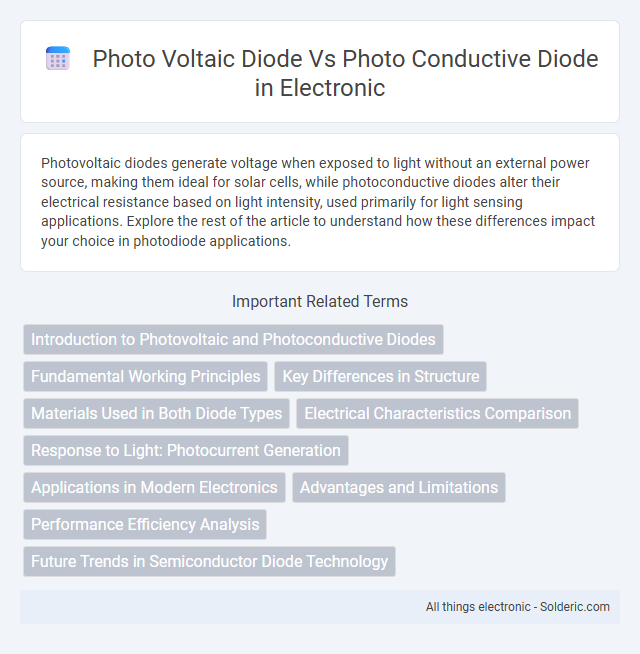Photovoltaic diodes generate voltage when exposed to light without an external power source, making them ideal for solar cells, while photoconductive diodes alter their electrical resistance based on light intensity, used primarily for light sensing applications. Explore the rest of the article to understand how these differences impact your choice in photodiode applications.
Comparison Table
| Feature | Photovoltaic Diode | Photoconductive Diode |
|---|---|---|
| Primary Function | Generates voltage when exposed to light (solar energy conversion) | Changes conductivity based on light intensity |
| Operation Mode | Operates in zero bias or photovoltaic mode | Operates under reverse bias (photoconductive mode) |
| Response Time | Generally slower due to charge generation and separation | Faster response to changing light intensity |
| Sensitivity | High sensitivity to light, producing voltage | Sensitivity depends on bias and material properties |
| Applications | Solar cells, photovoltaic sensors | Light sensors, photodetectors, optical switches |
| Power Output | Generates electrical power from light | Does not generate power, changes current flow |
Introduction to Photovoltaic and Photoconductive Diodes
Photovoltaic diodes convert light directly into electrical energy through the photovoltaic effect, commonly utilized in solar cells for generating electricity. Photoconductive diodes, by contrast, change their electrical resistance in response to light intensity, making them ideal for light sensing applications. Understanding the differences in operation and function helps you select the right diode for energy conversion or light detection needs.
Fundamental Working Principles
Photovoltaic diodes generate voltage and current when exposed to light by converting photons directly into electrical energy through the photovoltaic effect. Photoconductive diodes alter their electrical resistance based on light intensity, increasing conductivity as illumination varies without generating significant voltage. Understanding these fundamental principles helps you select the right diode type for applications like solar cells or light sensors.
Key Differences in Structure
Photovoltaic diodes generate voltage when exposed to light due to a p-n junction designed to separate charge carriers, while photoconductive diodes change their electrical resistance based on light intensity without producing voltage. The photovoltaic diode features a built-in electric field that drives current flow, whereas photoconductive diodes rely on light-induced conductivity changes across a semiconductor material. Your choice depends on whether you need voltage generation or variable resistance for specific light-sensing applications.
Materials Used in Both Diode Types
Photovoltaic diodes commonly utilize silicon or gallium arsenide due to their efficient light absorption and charge carrier generation properties, enabling effective conversion of photons into electrical energy. Photoconductive diodes often employ materials like cadmium sulfide (CdS) or lead sulfide (PbS), which exhibit variable electrical resistance when exposed to light, making them suitable for light sensing applications. The choice of semiconductor material directly influences the performance characteristics, spectral response, and efficiency of each diode type in their respective optoelectronic applications.
Electrical Characteristics Comparison
Photovoltaic diodes generate a voltage when exposed to light by creating a junction potential without external bias, exhibiting low dark current and high open-circuit voltage, making them ideal for solar cell applications. Photoconductive diodes require an external reverse bias to operate, showing increased conductivity under illumination due to photogenerated carriers, characterized by faster response times but higher dark currents. The electrical performance contrast hinges on their operational mode: photovoltaic diodes prioritize energy conversion efficiency with stable voltage output, while photoconductive diodes emphasize sensitivity and speed in light detection.
Response to Light: Photocurrent Generation
Photovoltaic diodes generate photocurrent by creating a voltage when exposed to light, harnessing the photoelectric effect to separate charge carriers at the p-n junction, enabling direct energy conversion. Photoconductive diodes increase conductivity under illumination, resulting in a current flow only when an external voltage is applied, as light reduces the material's resistance by generating electron-hole pairs. Photovoltaic diodes provide a self-powered response with faster reaction times, while photoconductive diodes are characterized by controlled current amplification under bias, affecting their efficiency and application in optical sensing.
Applications in Modern Electronics
Photovoltaic diodes are widely used in solar energy harvesting applications due to their ability to convert light directly into electrical current, making them essential in solar panels and light sensors. Photoconductive diodes, on the other hand, are primarily employed in photodetectors, optical communication systems, and imaging devices because their conductivity changes with light intensity, allowing for precise light measurement and signal detection. Your choice between these diodes depends on whether you need energy conversion or sensitive light detection in modern electronics.
Advantages and Limitations
Photovoltaic diodes generate voltage and power when exposed to light, offering high sensitivity and efficient energy conversion ideal for solar cells, but they can suffer from lower response speeds and sensitivity to temperature changes. Photoconductive diodes exhibit variable resistance under illumination, providing faster response times suitable for optical communication, though they require an external bias and often consume more power. Understanding these differences helps you select the right diode for applications balancing speed, sensitivity, and power requirements.
Performance Efficiency Analysis
Photovoltaic diodes exhibit higher performance efficiency due to their ability to convert light directly into electrical energy with minimal recombination losses, achieving typical conversion efficiencies above 20%. Photoconductive diodes, relying on changes in resistance under illumination, generally show lower efficiency and slower response times, making them less effective for energy harvesting applications. Performance metrics such as quantum efficiency and response speed highlight photovoltaic diodes as superior in applications requiring rapid, efficient photoelectric conversion.
Future Trends in Semiconductor Diode Technology
Future trends in semiconductor diode technology emphasize the integration of photovoltaic diodes with enhanced energy conversion efficiency through novel materials like perovskites and organic semiconductors. Photoconductive diodes are evolving with ultra-fast response times and improved spectral sensitivity using quantum dots and nanostructured materials. Advancements in flexible substrates and nano-fabrication techniques are expected to drive innovation in both photovoltaic and photoconductive diodes, enabling next-generation wearable and IoT devices.
Photo voltaic diode vs photo conductive diode Infographic

 solderic.com
solderic.com